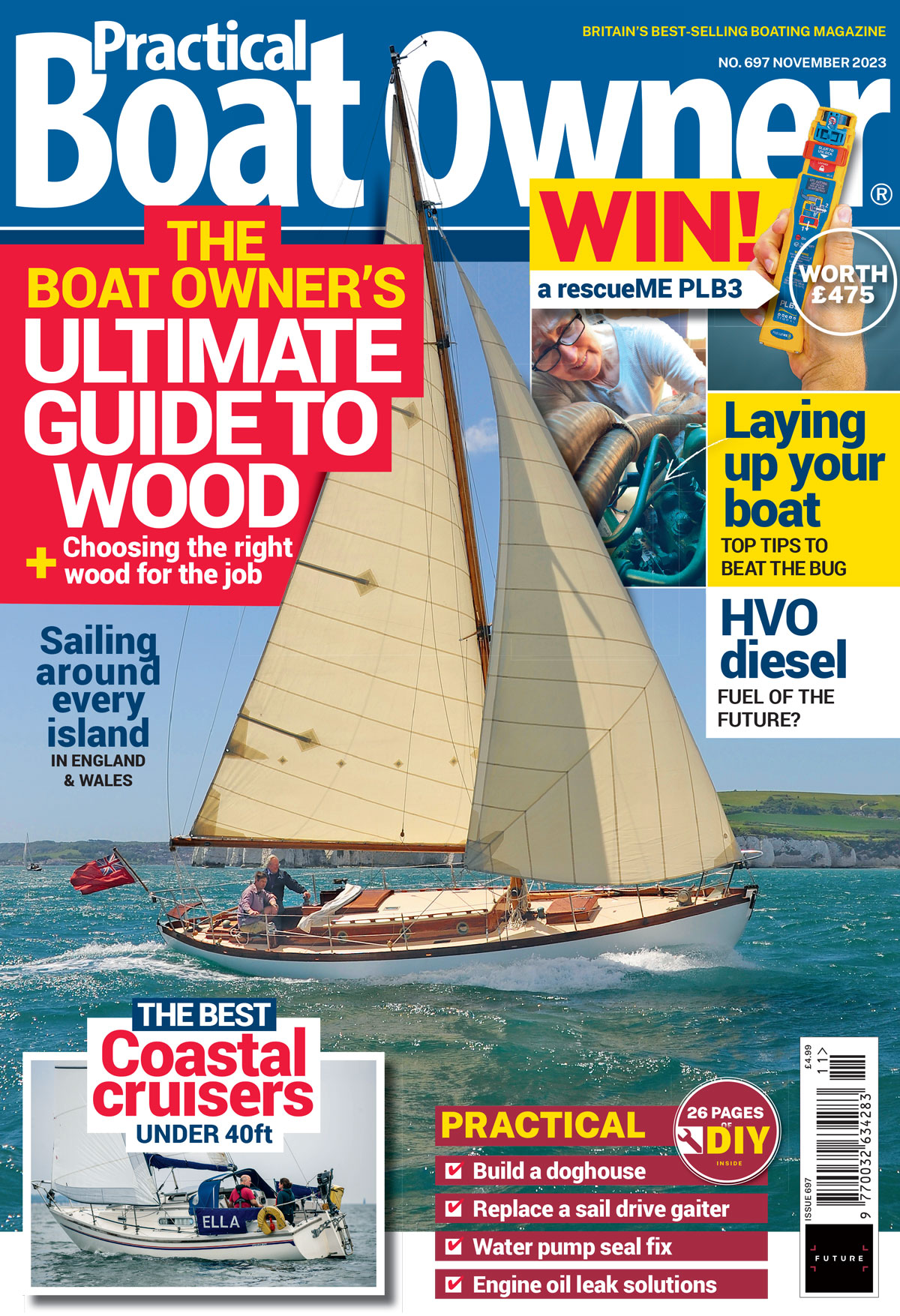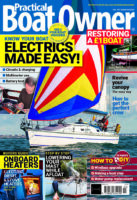Can rigging your jackstays in a different way really save lives? PBO reader Willem Bijl reckons it can, so David Harding put his ideas to the test
One subject that never goes away is man overboard rescue procedure.
And it never should go away, because it’s fundamental to safety afloat.
Any man 0verboard news story can’t help but affect us all and make us think what might happen if we or one of our crew were to go overboard, tethered or not.
Willem Bijl got in touch after reading our test of Oscar Mead’s TeamO lifejacket, that is designed to ensure that, if you’re being towed in the water on the end of a lifeline, you’re on your back and that your head is above water.
You have a much better chance of survival in this position than on your front with your head being dragged beneath the waves, as our testing has shown can so easily happen with conventional harnesses or lifejackets.
The reason for the reference to ‘being towed’ is that, as our various trials have demonstrated, it can be hard to bring a boat to a stop or near-stop quickly enough to save someone who has gone overboard on the end of a harness.
Being towed on our front at no more than a couple of knots for only 60 seconds or so is enough to drown most of us.
Someone who goes over without being seen, or without prompt action from an experienced crew, will probably be pulled along at speed for much longer than a minute.
Having taken part in half a dozen or so MOB-related trials over the years I have been forced to conclude that, in some circumstances, your survival chances would be greater if you’re not on a tether.
You might or might not be recovered, but at least you wouldn’t be drowned almost instantly.
Man overboard rescue procedure: the jackstay solution
Willem Bijl has developed his own approach to the problem on his Waarschip 740 Flotaxe.
Instead of rigging the jackstays along the deck, as on most boats, he has them along the coachroof.
Continues below…
Man overboard: recovering a casualty from a marina
Rupert Holmes shares top tips on how to avoid the dangers of falling in while in a marina and how…
Video: Man Overboard – recovery under power
Getting back to a man overboard under power
Video: Man Overboard – Quick Stop method
The RORC-recommended Quick-Stop method of getting back to a MOB.
Video: Man overboard – the reach-tack-reach method
‘Man overboard!’ It’s a cry that chills the blood. But most of us go sailing to relax and enjoy some…
This brings them further inboard, reducing the outboard limit of the tether and, says Willem, keeping someone who has fallen overboard higher out of the water.
Reducing the length of the lifeline itself would restrict movement around the boat, so Willem’s lines are the standard 1.75m (5ft 9in) and the positioning of the jackstays allows him to reach any part of the deck.
Since Willem volunteered to have his system tested, I took nFred – the life-size dummy kindly loaned by Aquasafe Powerboat School – to the Blackwater, put him in a conventional lifejacket and set off with Flotaxe to see how it works.
Where to tether
Apart from the position of the jackstays, many other factors play a part in determining the fate of someone who falls overboard.
Higher freeboard and/or falling over from the windward side, especially over the top of the guardwires, might mean being suspended with only your feet in the water – more uncomfortable than life threatening.

Being towed under power at 3 knots: From near the bow and below the guardrails, Fred looks to have marginal prospects. Credit: David Harding
On the other hand, falling under the guardwires on the leeward side when a boat is well heeled will almost certainly land you straight in the drink.
Willem’s boat has modest freeboard by modern standards, but with the lifeline led under the guardwires the attachment point on the lifejacket was well above the water when the boat was moving.

Downwind under sail: With the boat upright and the lifeline over the guardwires, his head is well above water and things are looking more promising. Credit: David Harding
We tried attaching Fred with the lifeline both over and under the guardwires, forward, amidships and aft, under power at different speeds and under
sail on both the windward and leeward sides.
There’s no doubt that rigging the jackstays inboard kept his head further from the water on many points of sail.

On the leeward side: Even over the guardwires, no one could last long at this sort of speed. Credit: David Harding
On other points (such as to leeward and under the guardwires) it might not make enough difference to prevent drowning, but every inch helps.
Helpful and long-suffering through Fred is, he does sometimes bend in ways that a living human doesn’t, so it can be hard to equate the position of his face (if he had one) in relation to the water with what might happen in real life.

Over the quarter to windward: It doesn’t look good for Fred given the way he is bending. A real person might stand a better chance. Credit: David Harding
If in doubt, we have to assume that someone would have drowned.
Clipping on to windward
Given Fred’s lack of independent mobility and our limited manpower we were unable to test one of the most significant aspects of the inboard jackstays, so Willem demonstrated afterwards.
Having the jackstays inboard allows him to attach his lifeline on the windward side, walk forward around the mast and work on the leeward side as far aft as the cockpit.
This way the lifeline is long enough not to restrict movement but, if he were to fall over the top of the guardwire to leeward, his attachment point would be anywhere from level with the gunwale to the same height as the upper guardwire, depending on his fore-and-aft position on the boat.
Clipping on to the windward jackstay is therefore by far the safest option.
If the jackstays were rigged along the deck it wouldn’t necessarily be possible, because the tether might then be too short.

Credit: David Harding
1. The lifeline’s attachment point is at the forward end of the cockpit but this still allows Willem to move right aft if necessary.

Credit: David Harding
2. From the forward end of the cockpit it’s easy to hook on to the jackstay and there’s no need to lean outboard

Credit: David Harding
3. Having to pass inside the shrouds is the only restriction, but Willem doesn’t find it a problem…

Credit: David Harding
4… and he can reach all the way to the bow.

Credit: David Harding
5 Here’s the biggest advantage: Willem can work on the opposite (leeward) side as far aft as the cockpit but couldn’t fall overboard from here.

Credit: David Harding
6. Further forward, the end of the lifeline would be outboard of the guardwires, but that’s hard to avoid. If the jackstays were along the deck you would want to clip on to the windward one too when working forward of the mast.
Willem’s man overboard recovery procedure
While we had a willing victim in the form of a by-now very dead Fred, Willem took the opportunity to try out his MOB recovery procedure.

Credit: David Harding
1 Fred has gone overboard so Willem immediately heaves to and deploys the emergency ladder.

Credit: David Harding
2. If the MOB were conscious and able to help himself, Willem would manoeuvre him towards the ladder…. but Fred isn’t, so Willem tacks back again, lets the jib flap, removes the mainsheet block’s snap shackle from the car and attaches it to the ring on Fred’s lifejacket.

Credit: David Harding
3. Willem brings Fred out of the water by hauling on the mainsheet while his son, Jozef, uses a fishing net to lift his feet. The net has proved to be a more useful recovery tool than a boathook for all sorts of things.

Credit: David Harding
4. The mainsheet is now block to block…

Credit: David Harding
5… so Fred is lifted over the guardwires and lowered on to the deck
PBO verdict
Any aspect of safety afloat involves multiple elements. I would still prefer to be wearing a lifejacket designed to ensure I was towed on my back because, no matter where the jackstays are attached, there’s always a chance you’ll end up in the oggin.
Willem points out that you’re on a longer tether with the TeamO lifejacket, but I reckon the benefits would outweigh any drawbacks in most situations.
When you’re on deck and trying to attach a recovery tackle to the lifejacket of someone in the water, it’s also easier to reach a lifting point behind the neck than on the chest.
As for the jackstays themselves, running them along the coachroof seems a thoroughly sensible idea.
It wouldn’t reduce the chances of drowning in every MOB situation, but should help in many.
By keeping wire or webbing away from underfoot it might also make an MOB incident less likely in the first place.
Enjoyed reading Man overboard rescue procedure: An alternative approach? 
A subscription to Practical Boat Owner magazine costs around 40% less than the cover price.
Print and digital editions are available through Magazines Direct – where you can also find the latest deals.
PBO is packed with information to help you get the most from boat ownership – whether sail or power.
-
-
-
- Take your DIY skills to the next level with trusted advice on boat maintenance and repairs
- Impartial in-depth gear reviews
- Practical cruising tips for making the most of your time afloat
-
-








